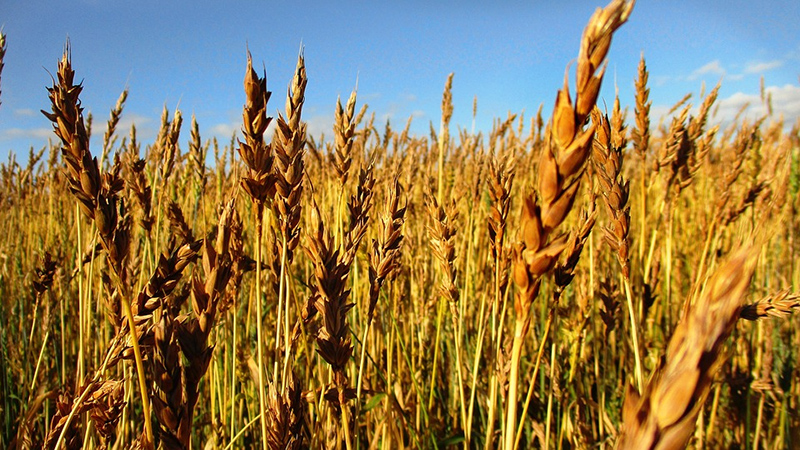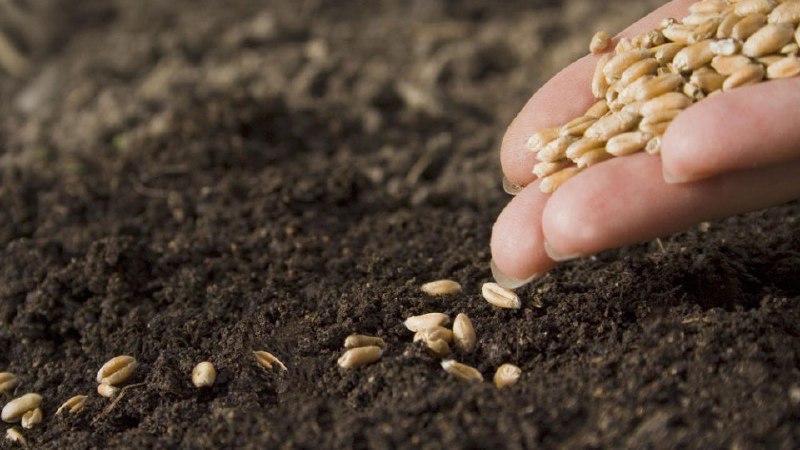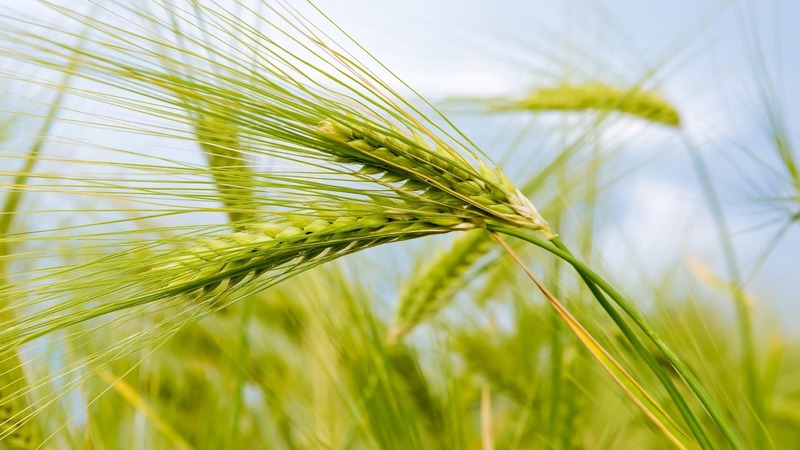Everything about growing spring wheat: cultivation technology from sowing to harvesting
Wheat is one of the most important agricultural crops. Bread, pastries, pasta and many other products are made from it. Production waste is used as feed. The culture is early, it tolerates frost well, and is resistant to lodging. We will tell you about the peculiarities of spring wheat cultivation in the article.
The content of the article
What is spring wheat
Spring - wheat, sown for grain in the spring. It completely goes through the growing cycle in the warm season and gives a bountiful harvest by autumn. In the Russian Federation, spring wheat is grown almost everywhere, including areas of risky farming.

Characteristics and biological features
The growing season for spring wheat is 70 to 120 days. It is not afraid of frost, germinates already at + 1 ... + 2 ° C, shoots appear at + 4 ... + 6 ° C. At the same time, the slow rates of germination allow it to easily tolerate low temperatures.
The transition to the tillering phase begins when the temperature is set at + 10… + 12 ° C. Ripening and milk ripeness require an increase in temperature up to + 20… + 25 ° C. Wheat does not tolerate too high temperatures (more than + 35 ° C).
Soils for culture are not suitable for all. Spring wheat grows well on sod-podzolic, sod-carbonate, loamy soils. In this case, the moisture content of the arable layer should be at least 70%.
Important! For full development, stemming and heading, wheat needs good lighting during the day. Spring culture refers to self-pollinated plants.
Spring wheat yield
On fertile soils with moderate moisture, the average yield in the Russian Federation is 30-35 c / ha. Application of modern cultivation technologies, timely protection against pests and diseases, introduction fertilizers increase this figure to 50 c / ha.
Cultivation technology
The complex of agrotechnical methods and techniques for growing spring wheat should be carried out sequentially. Sowing and harvesting are carried out as soon as possible. If sowing is extended in time, there will be difficulties with harvesting. If the crop is not harvested within 5-10 days, a significant part of the grain will die on the vine.
The main stages include:
- preparation of soil and planting material;
- sowing in compliance with the rules of turnover;
- fertilization;
- protection from pests and diseases;
- crop care;
- cleaning;
- drying and storage.
In preparation for sowing, a weekly schedule of technological operations is drawn up, which is adjusted as the weather conditions change.
Precursors of spring wheat in crop rotation
The culture develops well after one- and perennial legumes, row crops and legumes, except for sunflower. The best predecessors are considered to be potatoes, flax, buckwheat, melons, fodder and sugar beets, as well as busy couples. In some cases, spring wheat is sown after winter wheat as an insurance crop. However, this can lead to the accumulation of pests and diseases.
It is impossible to place wheat on uncultivated lands: the weakness of the root system will not allow it to develop normally and the plant will be driven out by weeds. Cereals (except corn) are also bad predecessors, since they have common diseases and deprive wheat of the nutrients necessary for grain ripening.
The most favorable growing conditions

Spring wheat does not tolerate hot climates and low humidity. Therefore, in our country, it is occupied by arable land in the Volga region, in the Urals, in Siberia, the Non-Black Earth Region. The presence of constant strong winds also adversely affects crop cultivation.
Spring wheat needs a sufficient amount of sunny days, especially during the earing and ripening period. The southern regions of the Russian Federation cultivate more winter wheat varieties, since spring wheat here may not withstand high temperatures... In the foothill regions of the North Caucasus, spring wheat shows good results in terms of yield.
The soil must be prepared for sowing in advance. Fall plowing is extremely important. After harvesting the predecessor, the soil is peeled to a depth of 6-8 cm, after 15-20 days, re-cultivation is carried out. In early spring, the fall is harrowed, and before sowing it is cultivated to a depth of 5-6 cm.
Spring wheat seeds
For sowing, seeds are selected calibrated, free from impurities. They are taken from high-yielding sites. Before sowing, the planting material is etched. For the destruction of dry smut - dry method, dusty - thermochemical.
The last stage of preparation is incrustation (coating with a mixture with microelements, growth stimulants and dressing agents), which will prevent the appearance of root rot, the development of smut and seed mold.
Sowing wheat
Spring wheat is one of the first crops planted in spring. As soon as the soil warms up to + 5 ... + 6 ° C, sowing work begins. Thanks to early sowing, wheat emerges amicably and manages to root well before weeds awaken.
Spring wheat is sown in a narrow-row method using technology. The seeding depth is 4-5 cm. If the grain is deeper, it will be difficult for the seedlings to break through to the surface. Wheat needs a strong bed and high soil moisture to wake up.
When to sow in spring
In each farm, the sowing dates are annually shifted in one direction or another. It depends on the actual onset of spring, snow melt and soil warming up to optimal temperatures.
Important! Seeding rate for hard varieties - 5-6 million grains per 1 ha, for soft grains - 4-5 million. With the use of modern technology, these indicators can be reduced by 2-3 times.
Super early seeding practice
The experience of the farmers after the cold spring of 1986 and high yields of spring wheat aroused interest in the technology of early sowing. Earlier planting dates protect wheat from droughts in May, damage by cereal flies and flea beetles. Rust is also less common on spring wheat at critically early crops.
Important! When deciding on a very early planting, one should take into account the typical weather conditions of the region. With the threat of severe frosts after the emergence of seedlings, there is a risk of their complete death.
Sowing technology

Recently, farms have not used the cross method, so as not to roll up the soil, not to consume fuels and lubricants (fuels and lubricants) and not to delay sowing.
In most agricultural enterprises, a narrow-row method is adopted, which allows wheat to grow evenly, get enough food and sunlight. This method facilitates further care and harvesting.
After the end of sowing, the field is rolled up with ring-ribbed rollers to improve the contact of seeds with the soil and accelerate the emergence of shoots.
Spring wheat crop care
3-5 days after sowing, the soil is harrowed to remove the crust and filamentous seedlings of weeds. In case of severe weediness, the procedure is again carried out in the phase of 2-3 wheat leaves.But it is better to avoid this, since repeated harrowing leads to a rapid drying out of the soil, as a result of which the cereal cannot form nodal roots. In the tillering phase, the soil is harrowed with a rotary hoe.
The main weed in the fields of spring wheat is wild oat. To combat it, triallate (avadex) is used, which is introduced during the pre-sowing soil preparation. During the growing season, amine salt, illoxan and "Dialalen" are used to kill weeds.
To protect wheat from diseases (powdery mildew, rust, rot) in the phases of booting and earing, plants are treated with Fundazol. For the destruction of pests, "Decis", "Volaton" and "Tsimbush" are used.
As soon as spring wheat begins to come out into the tube, the crops are treated with the "Tur" preparation. This will protect crops from lodging. It is permissible to use herbicides and insecticides at the same time, if necessary.
Intensive technology of cultivation of spring wheat
The use of the latest methods of soil preparation and cultivation, the maximum use of mechanized labor, the combination of advanced plant protection products and effective fertilizers are only a small part of what intensive technology includes.
During the planning period for sown areas, agronomists take soil samples, examine it, and draw up a field passport. In accordance with this document, a plan for preparing for sowing is prepared, which includes:
- composition and timing of fertilization;
- requirements for plowing depth and other stages of soil cultivation;
- selection of seed;
- anti-erosion measures;
- protection from pests and diseases at all stages of cultivation;
- planting and harvesting methods.
Thanks to this approach, the farm not only saves material and technical resources, but also increases the yield to 55-60 c / ha.
Features of the growth and development of spring wheat

The growing season of the culture includes the following phases: germination, emergence, tillering, tube emergence, panicle emergence, flowering, ripening. Depending on the phase, the preferences of the culture change - from high humidity in the first and second, to the minimum - in the latter.
Approximate timing of the phases:
- germination - 5-7 days;
- emergence of shoots - 15-20 days;
- tillering begins when 3-4 leaves appear and ends in the phase of 8-9 leaves - by this time 11-25 days have passed;
- going off the hook heralds emergence, development and growth ears - this process lasts about a month;
- heading - 2 months after germination, the ear leaves the sheath of the upper leaf, the period lasts about 10 days;
- flowering lasts no more than a week;
- ripening - 1-1.5 months.
Attention to the transition from one phase to the next allows for effective methods of processing wheat fields and fertilizing.
Ripening of seeds
Spring wheat grain goes through three stages of maturation:
- milk ripeness - 1-2 weeks;
- wax - 1 week;
- full - 12-16 days.
Yield statistics

Spring wheat is grown in our country slightly less than winter wheat. About 13 thousand hectares of arable land are occupied by crops. At the same time, the areas for crops have been continuously growing over the past 30 years (since 1990).
The Krasnodar Territory is the leader in wheat yield in the Russian Federation - an average of 55-60 c / ha is harvested here. In second place is the Oryol region with 40-45 centners / ha. The third place is shared by the Stavropol Territory and the Rostov Region, where the wheat yield ranges from 35-39 centners / ha.
Conclusion
Spring wheat in our country is cultivated by farms in a wide range of climatic zones. This crop is early, tolerates frost well, ripens during the short warm summer and gives generous yields.
The cultivation technology is based on the requirements for proper preparation of planting material, soil cultivation, fertilization and protection of plants from pests and diseases. The yield in our country is close to record.Many farms show results above the world average, while the quality of Russian grain is in many ways superior to foreign similar varieties.